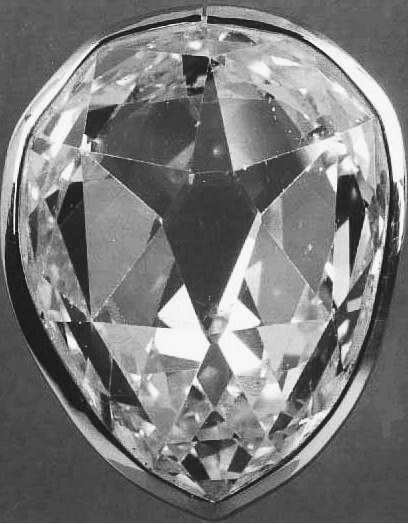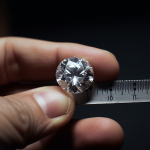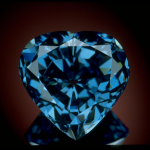Diamond Prices
Read moreThe Sancy Diamond
The Cursed French Crown Jewel
The Sancy Diamond is believed to have started as the legendary Balle de Flandres – a historical diamond that weighed around 100 carats! The Sancy has been traced throughout history for around 500 years in which it has passed through many hands and over 15 countries. There are many legends associated with it such as the stone being cursed and the gem making its owner invincible. It was even swallowed by a servant at some point. Read on to learn more about the Sancy diamond’s journey!
In this article you will find:

- Discovered in
- 14th century
- Country of Origin
- India
- Mine of Origin
- unknown
- Carat Weight
- 55.23 carats
- Cut Shape
- Shield-shaped brilliant cut
- Clarity
- Clean with a small flaw near the surface.
- Color
- No official color grade, but suggests a good color.
- Previous Owners
- Valentina Visconti
- Duke John the Fearless (Burgundians)
- Charles the Bold (Burgundians)
- Jacob Fugger
- King Manuel I of Portugal
- Portuguese crown jewels
- Antonio de Crato
- British Crown (Queen Elizabeth I)
- Nicolas de Harlay, seigneur de Sancy
- Henry III of France
- Henry IV of France
- Various owners, including murder mystery incident
- King James I
- Cardinal Mazarin
- French Royal Jewels (until the French Revolution)
- Prince Demidov of Russia
- Sir Jamsetjee Jeejeebhoy
- William Waldorf Astor
- Current Owner
- Louvre Museum
- Estimated Value
- Sold to the Louvre for 1 million euros in 1978. No current estimated value available.
The Origins of the Sancy Diamond
The stone is believed to have originated in India around the 14th century. During that time India was the only place where diamonds were found. Moreover, the diamond’s characteristics support the hypothesis that India is the diamond’s provenance.
Valentina Visconti
Legend has it, that a Venetian diamond cutter smuggled the original stone (believed to be the Balle de Flandres) out of India. The first record of the gem in Europe is in the dowry registry of a lady named Valentina Visconti. Visconti was the daughter of the Duke of Milan. She married Louis I, Duke of Orleans whose brother was King Charles VI of France. Visconti’s husband was killed by the Burgundians, and following his death, she sold the Sancy Diamond and used the money to fund the fight between the Armagnac and the Burgundians.
This conflict became known as the Armagnac-Burgundian Civil War, where two factions of the French royal family fought for supremacy. After the Armagnac defeat, the diamond went to Duke John the Fearless (1371 – 1419), under whose care it remained for several generations.
The Burgundians emerge victorious
During the time it was guarded by Charles the Bold, king of the Burgundians, the Sancy Diamond was a symbol of victory. The Dukes of Burgundy believed it to possess great powers. The gemstone brought good luck to anyone who wore it and allegedly made them invincible. The Dukes always wore it as a talisman into battle and returned victoriously – that is until the Battle of Grandson in 1476. Charles the Bold lost the Sancy during that battle which seemed to justify the misfortune that plagued him after. He would lose the next two battles against the Swiss.
Although the Sancy was lost to the Burgundians, it was not lost to history – the Bishop of Basel hid the gem away alongside the Three Brothers – another famous jewel. A few years after that, the gem was sold to Jacob Fugger, a major German merchant, mining entrepreneur, and banker.
The cutting of the Sancy Diamond
Fugger had the Sancy cut into a 55.23-carat diamond which is the weight we know the diamond has currently. The Sancy was modified and cut into a brilliant cut that resembled a shield shape. The dimensions of the gem were 25.7 mm long, 20.06 mm wide, and 14.3 mm deep. The unusual diamond was also noticeable for having symmetrical facets and no pavilion, with two crowns placed on top of one another.
The modern ownership history of the Sancy Diamond
Fast forward a few ages, the diamond eventually found its way to King Manuel I of Portugal, also known as King Manuel the Fortunate. After his death, the diamond became part of the Portuguese crown jewels. The Sancy diamond remained part of the crown jewels until Antonio de Crato’s right to the throne was threatened by the Spanish invasion.
The Sancy is acquired by the British Empire
De Crato escaped to France with most of the Portuguese crown jewels intending to get the aid of the French and British to regain his throne by selling most of the jewels in his possession.
This is how the Sancy found itself in the hands of the British Crown and more specifically – Queen Elizabeth I. The Queen pawned the gem sometime after this to get funds to help liberate the Dutch from the Spanish. The Sancy was pawned in Antwerp but since it did not get redeemed – it found its way to Amsterdam, the historical diamond capital of the world.
The Sancy earns its name
In Amsterdam, it was acquired by a gentleman by the name of Nicolas de Harlay, seigneur de Sancy. De Sancy was well-liked in the French court and later became the French ambassador to the Ottoman Empire. Another theory holds that he purchased the diamond during his time as ambassador in Constantinople. However, how the Sancy Diamond found its way to the Ottoman city in the first place is unclear. Sancy was a diplomat and lover of gemstones and it was known he maintained a large collection of them.
De Sancy made good use of his diamond collection. The use of diamonds in fashion was becoming more and more popular at the time, with this higher demand, De Sancy capitalized by loaning his diamonds to other aristocrats. Henry III of France borrowed the gem from De Sancy and used it to decorate his hat. Henry III reportedly went bald early in his life and sought to cover this up by wearing a hat. Meaning the stone was effectively a very fancy toupe for some time.
Henry IV also arranged to borrow the diamond from de Sancy. However, he was less concerned with his looks and much more concerned with financing an army. The stone was used as collateral. So, it is fair to say that whilst the Sancy Diamond was still in possession of de Sancy, it was subjected to heavy circulation.
Murder mystery: the Sancy was thought to have been lost forever
Amidst all of the comings and goings, most notably, there was an instance when the stone was thought to have disappeared forever. The stone was given to a messenger who vanished. Most people thought that the man had stolen the diamond but de Sancy was convinced of the man’s moral fiber and believed that something was wrong. An investigation was conducted. The investigation concluded with the location of the courier, dead and robbed. When the body was inspected – the Sancy diamond was found in the man’s stomach. Thus, shockingly to those who doubted his integrity, the messenger remained loyal to the end and displayed a fierce allegiance to Sancy by protecting the gem entrusted to him with his life.
De Sancy sells the stone
Later on, de Sancy ran into some financial difficulties for which he was forced to sell the stone. That is how it came to be in King James I’s possession. This is the point when the gem started being called the Sancy Diamond. The gemstone was inherited by his son Charles I who presented it to his wife – Henrietta Maria as a wedding gift. It is known Henrietta Maria pawned off the Sancy Diamond along with some other crown jewels twice. First, to fund her husband’s military efforts against the French and the Spanish, and a second time to prepare for possible a possible military campaign as her husband, King Charles I, was constantly under siege from his parliament. After facing multiple defeats, the king sold the Sancy diamond to Cardinal Mazarin, the prime minister of France who, following his death, left the diamond to the French king.
The Sancy Diamond becomes part of the French Royal Jewels
After Cardinal Mazarin’s death, The Sancy Diamond remained part of the French Royal Jewels until the French Revolution. During a raid of the Royal Treasury, the Sancy was stolen alongside the Regent Diamond and the Hope Diamond. The diamond then disappeared for a while – there are conflicting theories on where it was.
Everyone knows in 1828 the Sancy was purchased by Prince Demidov of Russia. He passed it down to his son who gave it to his wife as a present on their wedding night. The Demidovs eventually sold the diamond to Sir Jamsetjee Jeejeebhoy – an Indian merchant prince. He, however, resold the Sancy Diamond only a year later and the stone disappeared yet again. It resurfaced in 1867 at the Paris Exposition, followed by another unknown period.
The Sancy Diamond resurfaced again in 1906 when it was bought by William Waldorf Astor. He was the 1st Viscount Astor. The stone remained with the Waldorfs until the 4th Viscount Astor, who sold the Sancy to the Louvre for 1 million euros in 1978, where the diamond remains to this day.
The technical characteristics of the Sancy Diamond
The Sancy diamond is a shield-shaped brilliant-cut diamond. It weighs 55.23 carats or 11,046 grams. The dimensions of the stone are 25.7 mm in length, 20.06 mm in width, and 14.3 mm in depth. Most of its facets are triangular, with a central pentagonal facet on each side. The shape of the diamond is so unique, that it was impossible to compare the stone’s color to a color-graded stone. Its general appearance suggests a good color, as well as a reasonably clean clarity. However, there is a small flaw near the surface that is repeated by the reflection of light in the facets. There are visible scratches on the pentagonal facets. Overall, there are no official grades for its color and clarity.
The Sancy Diamond’s significance
The Sancy Diamond is one of the most important jewels of historical value belonging to the Galerie d’Apollon section of the Louver Museum. Having been owned by numerous monarchs, the Sancy helped fund the royal’s lavish lifestyles and military efforts for years. The Sancy was part of the French crown jewels during the French revolution – a pivotal moment in modern history. Some of the stolen jewels were used to fund the revolution, others were hidden in secret apartments around the country. Although the Sancy Diamond was not always in possession of the French; it represents much of their culture and their progressiveness. The Sancy diamond’s tale and the stone itself are reminiscent of The French people’s intrinsic move to strive forward with the times.
The Sancy is part of the French Cultural Heritage in the Louvre
The Sancy Diamond is available to the public in the Louvre, where it is on display in the Galerie d’Apollon among other beautiful jewels of the French crown’s heritage. The gallery in which the diamond resides is meant to represent King Louis XIV’s obsession with the god Apollo. It is known the king identified himself with the god Apollo and so, the space is filled with intention to reflect this aspect of the Sun Emperor’s mind. King Louis gathered the greatest artists of the time to work on the Galerie d’Apollon. Later on, it was the same team who worked on the Hall of Mirrors at the Château de Versailles.
We hope you enjoyed the read!
If you’d like to read about other famous diamonds like the Orlov, Eureka, or Premier Rose diamonds, you can visit Ajediam’s Famous Diamonds glossary. Or, if you’re feeling inspired, you can browse Ajediam’s premium diamond collections shop.



